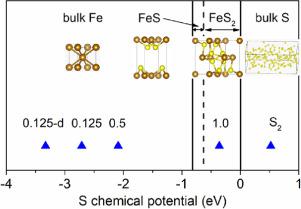Surface Science ( IF 1.9 ) Pub Date : 2021-02-28 , DOI: 10.1016/j.susc.2021.121835 Fagen Li , Zhaohui Zhou , Chaozheng He , Yufei Li , Lin Zhang , Dajiang Zhu

|
In this paper, spin-polarized periodic density functional theory-based simulations were performed to investigate H2S adsorption and dissociation on the defective and strained Fe (110) surfaces which exist in real oil exploitation and transport. It was found that the defective surface facilitates H2S adsorption and dissociation with respect to the perfect surface, while the homogeneous external stresses, giving rise to uniform lattice expansion, show negligible effects for the strain estimated from experiment. More interestingly, the simulations predicted a correct order of phase transition at the Fe (110) surface by using the chemical potential based thermodynamic model, that is, from the elementary Fe crystal to the FeS crystal to the FeS2 crystal to the elementary S crystal with the S coverage on the Fe (110) surface increasing.
中文翻译:

缺陷或应变Fe(110)上的H 2 S分解和硫化铁的后续形成:密度泛函理论研究
在本文中,进行了基于自旋极化的周期性密度泛函理论的模拟,以研究在实际采油和运输中存在的有缺陷和应变的Fe(110)表面上H 2 S的吸附和解离。发现缺陷表面相对于完美表面促进了H 2 S的吸附和离解,而均匀的外应力导致均匀的晶格膨胀,对于根据实验估计的应变显示出可忽略的影响。更有趣的是,模拟使用基于化学势的热力学模型预测了Fe(110)表面的正确相变顺序,即从基本的Fe晶体到FeS晶体再到FeS 2 到单质S晶体,Fe(110)表面上的S覆盖率增加。

























 京公网安备 11010802027423号
京公网安备 11010802027423号